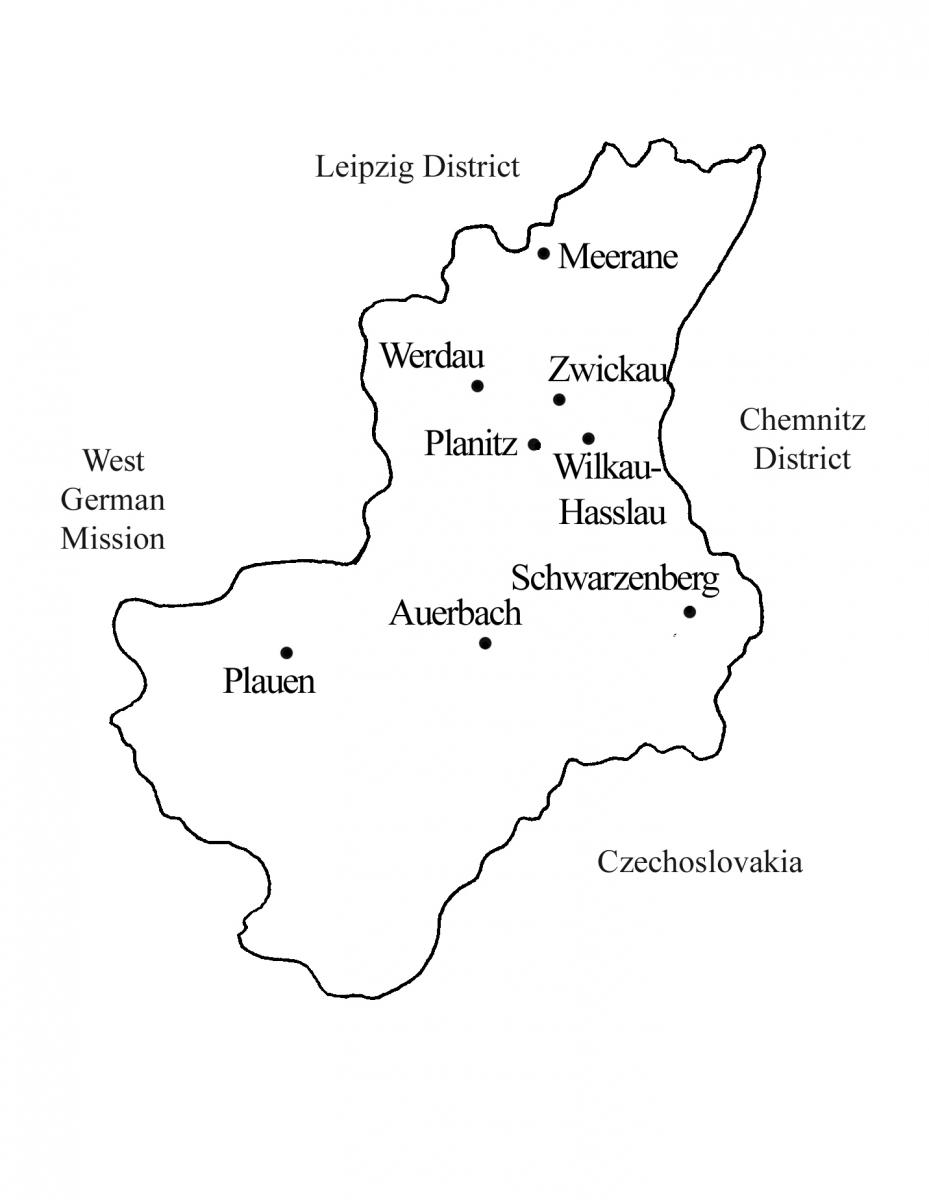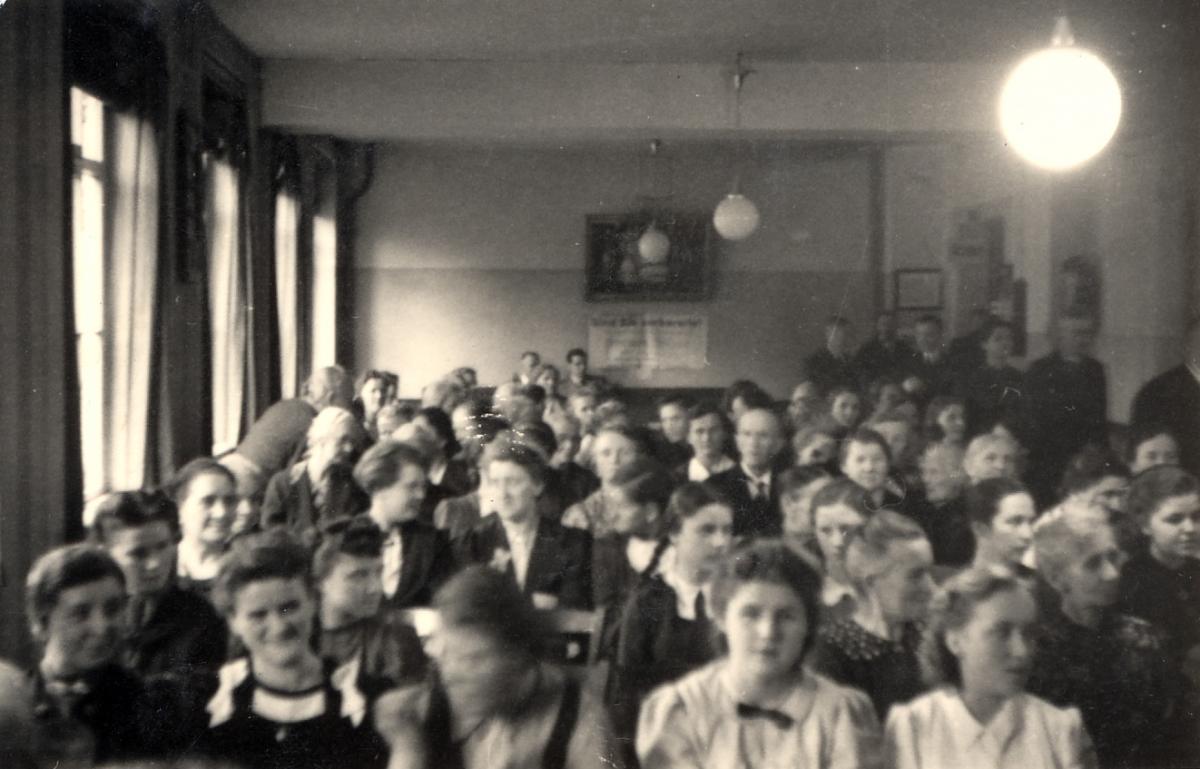Zwickau District
Roger P. Minert, In Harm’s Way: East German Latter-day Saints in World War II (Provo, UT: Religious Studies Center, Brigham Young University, 2009), 479-81.
In the former kingdom of Saxony, where The Church of Jesus Christ of Latter-day Saints had its highest concentration of members in Germany before World War II, the Zwickau District likely had the highest number of branches in the smallest territory. The district territory measured approximately forty-two miles north-south and twenty-five miles east-west. Within that small area were eight branches and one group of the Church with a total membership of 699 at the end of 1939.
Traveling distances to district conferences in Zwickau were relatively short. Meerane is ten miles to the north, Wilkau-Hasslau two miles to the southeast, Beutha twelve miles to the east, Schwarzenberg eighteen miles to the southeast, Auerbach seventeen miles to the south, Planitz two miles to the southwest, Plauen twenty-four miles to the southwest, and Werdau five miles due west. One could take the train from Zwickau to every branch city in the district, with the exception of Planitz (in the Zwickau metropolitan area) and Beutha (where a small group of Saints met).
 The Zwickau District of the East German Mission shares borders with the nation of Czechoslovakia, the West German Mission, and the districts of Chemnitz and Leipzig.
The Zwickau District of the East German Mission shares borders with the nation of Czechoslovakia, the West German Mission, and the districts of Chemnitz and Leipzig.
Adult women constituted the major demographic group in the Zwickau District—more than 63 percent. There was also a very large number of adult males who did not hold the priesthood—111. Relatively few children (barely 6 percent) lived in the nine units of the district when World War II approached.
| Zwickau District[1] | 1939 | 1940 | 1941 | 1942 |
| Elders | 38 | 36 | ||
| Priests | 9 | 10 | ||
| Teachers | 18 | 23 | ||
| Deacons | 32 | 29 | ||
| Other Adult Males | 111 | 109 | ||
| Adult Females | 438 | 433 | ||
| Male Children | 24 | 24 | ||
| Female Children | 20 | 22 | ||
| Total | 690 | 686 | 675 | 666 |
The district president was Bernhard Unger until November 6, 1938, when Walter Fassmann Sr. of the Zwickau Branch was named to that office.[2] Brother Fassmann served throughout World War II and for several years thereafter. As of March 19, 1939, Carl Neumärker was the first counselor in the district presidency and Alfred Klopfer the second counselor.[3] Sister Lina Ebisch of the Zwickau Branch was appointed district Relief Society president on August 7, 1938.[4]
The history of the East German Mission provides interesting details regarding the Zwickau District until March 1939, beyond which the mission records have been lost. For example, from November 5 to 23, 1938, Elder Roger A. Brown of the East German Mission Auxiliary Committee visited the branches of the Zwickau District “and discussed with the branch presidents and leaders of auxiliary organizations their various problems and gave suggestions and advice for improvement.”[5]
 Members of the Zwickau District gathered for a conference in 1940 (M. Gangien Mannek)
Members of the Zwickau District gathered for a conference in 1940 (M. Gangien Mannek)
On Saturday and Sunday, November 5–6, 1938, the fall conference of the district was held in Zwickau. President Alfred C. Rees of the East German Mission presided. The attendance at the general session on Sunday included 250 members and eighty-two friends.[6] It seems that the members in the district were quite willing to invite friends to join with them on these occasions. As in other districts in the East German Mission, the district conferences in Zwickau included cultural events such as concerts, dances, and theatrical performances in the years leading up to the war. Unfortunately, many such events were no longer possible when the privations of the war increased. Nevertheless, district conferences in Zwickau were held twice annually, at least through the year 1944.
The last conference for which a report exists in the record of the mission office in Berlin was held in Zwickau on Saturday and Sunday, March 18–19, 1939. Herbert Klopfer of the mission office staff represented President Rees on that occasion. The main session on Sunday evening was attended by 280 members and friends.[7]
Notes
[1] Presiding Bishopric, “Financial, Statistical, and Historical Reports of Wards, Stakes, and Missions, 1884–1955,” CR 4 12, 257.
[2] East German Mission Quarterly Reports, 1938, no. 46, East German Mission History.
[3] Ibid., 1939, no. 58.
[4] Ibid., 1938, no. 35.
[5] Ibid., 1938, no. 46.
[6] Ibid., 1938, no. 46.
[7] Ibid., 1939, no. 59.
